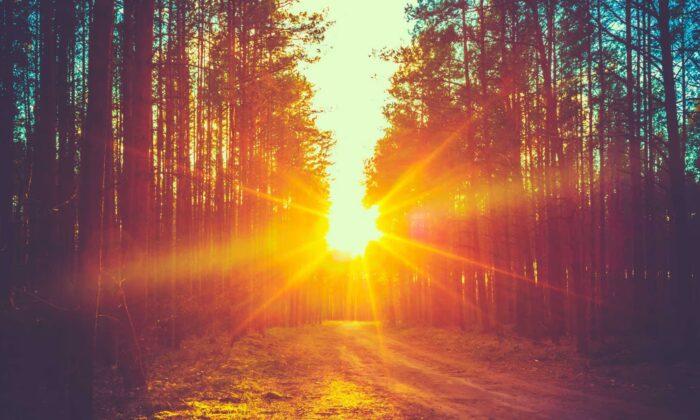March 17, 2020, was the first day of the end of civilized life, the one for which Western peoples had been fighting for one thousand years. It was the first full day following the lockdowns that ended all rights and liberties, including even the right to have friends for dinner or go to community worship services or attend or hold weddings and funerals.
The sun did peer up over the horizon and did bring its light, but this time it did not bring hope. It shone over a world but only highlighted the absence of joy, opportunity, and excitement over the unexpected blessings that would come our way. All of that had been taken away and suddenly, seemingly without warning.
The sun that day shone a light on wreckage and terror of a society consumed in tyranny and fear. It was there as if to mock hope, its every ray broadcasting disdain for our own sense of security and confidence in the future. Its every hour above the horizon torched our optimism, including all of its signs on earth: music, dancing, and human relationships.
It became obvious that this would keep happening day after day—the sun cares not for lockdowns—regardless of what the masters of the worldly universe did to us. And it was at that point, we all had to make a choice: despair or fight our way through this thicket of disaster.
Some of us took longer than others to decide, which is understandable because the shock and awe imposed upon us also disabled our clarity of mind. Three years later, we should know the answer. We must fight. The sun in its rhythmic regularity of rising and falling is always beckoning us toward living meaningful and free lives. Otherwise, what possibility could be the point?
We recall those days now and wonder how and why this all happened. Not one minute has passed since that day when I’ve rested from asking that question. Every day it feels like we get closer to knowing. And yet the truth keeps being ever more elusive with every revelation of the depths of the conspiracy, the range of the players, the interests at work, and the forever toggle between fear, plot, ignorance, and malice.
At some point in the last three years, even the official story of why seems to have slipped away from public life. The lockdowns didn’t work. The travel restrictions were pointless. The plexiglass, the one-way aisles, the oceans of sanitizer dousing everything, the constantly-changing regulations on whether we should stand or sit indoors or out, and the two yards of distance mandated between any two people were all brutal failures. The masking that hid our smiles for two years achieved nothing but dehumanization. Then the magic bullet—the so-called vaccines—flopped too and even multiplied the suffering. And then, at some point, it all just went away.
What precisely are we supposed to believe was the reason they wrecked the world as we knew it? I can’t even seem to find an attempt at an explanation anymore. All we see are trolls hounding us to this day for having chosen the wrong tribe during the great upheaval. The tribe I chose was the one that decried the whole thing, but that was not the fashionable or winning side. To this day, we are despised for having been right.
Lacking a big theory and a clear sense of a single cause, we’ve tended to replace it with a narrative. We know now that the virus was already spreading in the US many months earlier, perhaps since September 2019. We know that vaccine development started sometime in January. We know of all the calls between the muckety mucks in late January and early February. We know that the elites led by Anthony Fauci seem to have gone all in on lockdowns by February 27, 2020.
Someone got to him on the 10th. We don’t know who or how. We are not likely to find out either because, as we’ve discovered over these last six months, it was the national security state that was in charge. That means that the real answers are clouded in secrecy. We have seen it all coming: when civilization crumbles, the real reason why would be classified.
My friends didn’t like the book: too Hegelian, too much premised on the American ideal as an imperial construct. I had no opinion on the merit of his argument but I did know that I wanted it to be true. And looking back, it’s clear to me now that I had long assumed it was true.
Then in one day it was all gone. That day was last Friday three years ago. The following day, three years later, the sun rose but no amount of light could take away the darkness.
St. John of the Cross writes about the dark night of the soul, the moment that comes in every life when one detects the seeming absence of God and we sense the terror of having been wrong and sense only isolation and darkness. The burden of his book is to map out the story of such a life and to reveal its inner purpose. The point of the dark night of soul, in all its desperation, is to inspire us to find our way, on our own, as mature adults, to the light of salvation.
“As a traveler into strange countries goes by ways strange and untried, relying on information derived from others, and not upon any knowledge of his own—it is clear that he will never reach a new country but by new ways which he knows not, and by abandoning those he knew—so in the same way the soul makes the greater progress when it travels in the dark, not knowing the way.”
The sun is out as I write, the same sun that was there before the darkness fell. So it will be tomorrow and the next day. Our job is clear, then: get through this period of suffering and find our way back to true enlightenment.





